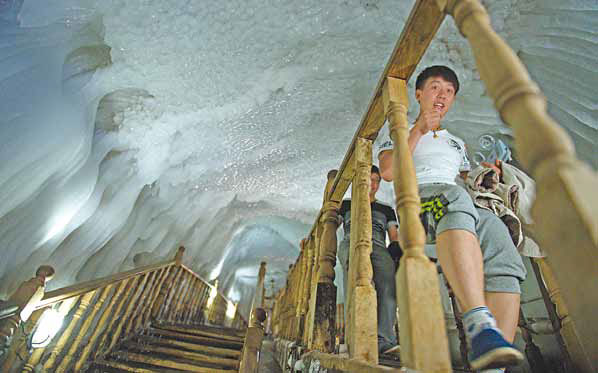Northern exposure
Updated: 2013-08-14 23:51
By Chen Liang (China Daily)
|
|||||||||||
A huge ice cave and an idyllic alpine meadow are among the less-known pleasures of visiting Shanxi province, but don't expect a 5-star experience just yet. Chen Liang reports.
Many county-level scenic spots in the country, especially those in North China, share a similar problem — poor exploitation of tourism. Symptoms include exaggerated names, overpriced admissions and accommodations, limited but expensive services, ugly buildings and few considerations for individual visitors.
 |
|
Colorfully illuminated ice turns the cave into a cool, crystal wonderland. [Photos by Wei Xiaohao and Chen Liang/China Daily] |
So when a friend invited me to his hometown, a remote county in Shanxi province, to visit Wannian ("Ten Thousand Years") Ice Cave and an alpine meadow on a locally famous mountain, I hesitated.
I don't like the name; it sounds like a gimmick. But my friend, who was born and grew up there, says these are true natural wonders and worth a visit.
His hometown, Ningwu, is only three hours' drive from Taiyuan, the capital of Shanxi, where I was on business recently. So I went with him for a two-day excursion, without much expectation.
We have our dinner at a restaurant overlooking a lake, which is one of the Ningwu Tianchi ("Heavenly Lake"). The lake is clean and peaceful. At about 2,000 meters above sea level, the breeze from the lake is cool even at the height of summer.
Around the lake, however, trees are small, the slopes are gentle, and the restaurant building and yurts around it are cement and tacky.
To be honest, the scenery is mediocre — nothing to compare with the other two famous "heavenly lakes", in Xinjiang autonomous region and Jilin province. But the fish caught here is fresh and delicious.
The lakes are about 20 km from the county town. After dinner, we drive about half an hour to Dongzhai township and check into a hotel near the entrance of Mount Luya National Forest Park.
The next morning, I find our hotel to be part of a recreational area that is still under construction. At this moment, it is a little noisy and dirty.
The gate of the forest park is newly completed and quite big. The good thing: There is no admission fee yet.
The road winding into the forest park is in excellent condition.
And it is certainly a surprise to find mature secondary coniferous forests, with tall spruce and pine trees, in an area near the Loess Plateau and in the province known for its rich resources of coal.
With the forests, everything becomes pleasant. The river is clear, flowers are blossoming, birds are chirping and the air is refreshing.
After a half-hour drive, we arrive at Wannian Ice Cave. The admission is 120 yuan ($20) per person, which is not surprising but disappointing. So is the LED screen, with the Chinese name of the cave, on top of a slippery cement tunnel that leads down to the entrance at the bottom of a sheer cliff.
A circuit with wooden steps leads visitors to explore the ice cave. It's like walking into a refrigerator — you feel the icy coldness even before you see the ice.
Yes, there is ice, a lot of it. On walls, on steps, on railings, hanging down from the ceiling like swords, and growing up from the ground like bamboo shoots.
The steps wind down to the cave, which has three levels open to visitors, and then up, into the world made of ice flowers, ice stalactites and stalagmites.
Bathed in light of different hues, they turn the cave into a colorful wonderland.
Later my friend tells me that the cave has a history of more than 3 million years. It is one of the largest ice caves found in the country.
While the ice cave is hidden in a valley of the Guancen Mountains, the Malun Grassland is on one of the mountaintops.
Driving 27 km from the park entrance and up to about 2,400 meters above sea level, we reach the end of the road and see booths selling snacks and drinking water. Sneakers are for rent — probably because too many visitors wear high-heeled shoes to the site and then realize they will need to climb.
After a half-hour hike, trees are suddenly gone and a broad alpine meadow spreads across the top of the slope and stretches into the horizon.
The 400 hectares before us are covered with a lush growth of green grass. Dozens of horses graze at their ease. In this season, various kinds of alpine flowers are in bloom. Pipits and rosefinches are breeding on the grassland.
At the top of the meadow, I see Mount Luya rising in front of me, across a broad valley.
With more than 200 rock peaks and rising 2,739 meters above sea level, Mount Luya is the summit of the Guancen Mountains and the major attraction in the forest park.
It will take a hardy hiker four hours to scale the summit and back to the meadow.
We don't have much time, but we sit in the meadow for a while and enjoy the spectacular panoramic views.
On the way back, I start thinking it's a shame that such a nice area has no lodging, no shuttle buses and no bike rental. That's the reality of traveling in many parts of North China, but it also means there are not big crowds of tourists with you.
Sun Ruisheng contributed to the story.
 |
|
With a history of more than 3 million years, Wannian Ice Cave is one of the largest of its kind in China. [Photo by Wei Xiaohao/China Daily] |
Today's Top News
China to investigate foreign automakers
Minors going online to buy smokes
Forbidden City bans lighters, matches
Israelis, Palestinians kick off peace talks
Manning 'sorry' for US secrets breach
Snowden case not to affect US-Russia talks
Slowing economy takes toll
Over 200 dead in Egypt's unrest
Hot Topics
Lunar probe , China growth forecasts, Emission rules get tougher, China seen through 'colored lens', International board,
Editor's Picks

|

|

|

|

|

|





